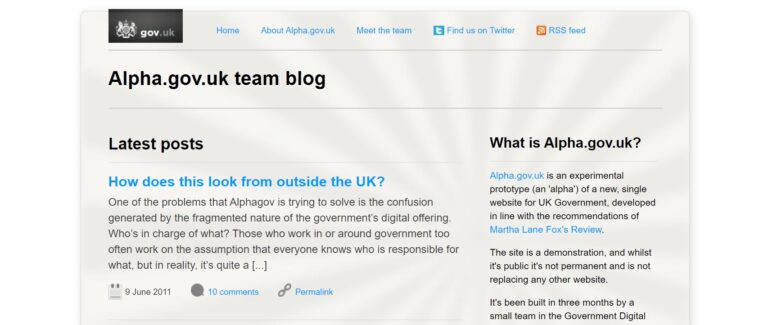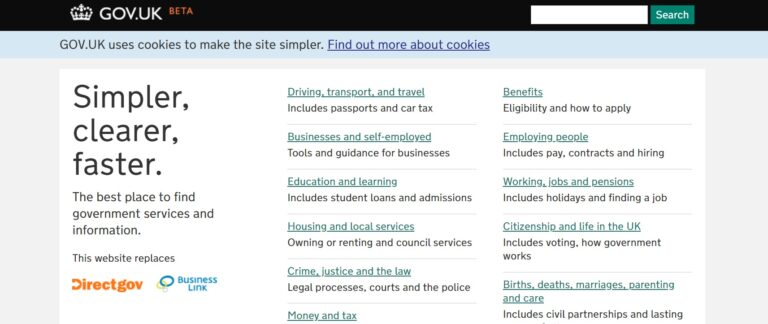To celebrate the UK Government Web Archive (UKGWA) turning 25 this week, we have released a video showing the evolution of one of the most important sites in our collection: GOV.UK. The video, put together by my colleague Kourosh Feissali, shows the site from its earliest stages to the present day. In this post I take a look at some highlights from the history of this ‘website for the nation’.
From November 2008 the UKGWA started to archive a larger number of sites as part of our Web Continuity Initiative. This supported the creation of the single government domain, GOV.UK, by archiving pages that were being retired so that users could be redirected to the UKGWA where appropriate.

The earliest example of GOV.UK in our collection is an ‘Alpha’ prototype that was archived on 10 June 2011. The site’s about pages describe a bold vision for a new single government website, informed by UK Digital Champion Martha Lane Fox’s 2010 report calling for ‘Revolution not evolution‘ in the government’s online services. These Alpha pages clearly show experimentation with the appearance of the site, for example, early versions include large background images of significant places in the UK, such as the Angel of the North or Buckingham Palace (to celebrate the Diamond Jubilee in 2012).

Nevertheless, some key elements remain consistent throughout the 10 years of the archive: the prominent search functionality and the links to access key information and services would be familiar to modern users of GOV.UK, as would the responsive mobile-friendly design.
By the time of our July 2012 capture, the site had entered Beta testing and the large background images had been dropped in favour of a cleaner look. As the Government Digital Service responded to user feedback, we see several different variations on this theme before settling on a more familiar design. On the 17 October 2012 the site ended its Beta testing phase and officially replaced its predecessors Directgov and Business Link.

From November 2012 we can chart the next major stage in the site’s development: its absorption of individual government department websites. In our 18th November capture, the homepage records that two of 24 ministerial departments were live on GOV.UK. This work continued apace and by January 2013, six ministerial departments and 11 other public bodies had transferred to the site, with all ministerial departments having transferred by May that year. Though other public bodies continued to be added, this marked a significant milestone in the ambition to provide a single point of contact between citizens and the government.

In August 2013 the site design was tweaked again, emphasising the search bar and introducing the blue and white colour scheme that is still used today. Indeed, there now followed a period of stability in the look and feel of the site. We continue to see an increasing number of public bodies and agencies incorporated into the site but otherwise, the design is consistent, punctuated only by occasional banners and coloured areas to emphasise important information such as preparations for Brexit or the government’s response to the COVID-19 pandemic. That the fundamental design of the homepage has remained so consistent is a tribute to how effectively it has served the needs of its users over the years, and to the vision of the teams that conceived of and implemented the new site back in 2011.
Amazing, thanks for all your hard work and for celebrating this.
You say: “On the 17 October 2012 the site ended its Beta testing phase and officially replaced its predecessors Directgov and Business Link”.
That is false.
Directgov continued to operate until at least May 2018, please see https://web.archive.org/web/20180511215817/https://jobsearch.direct.gov.uk/register.aspx?redirect=http%3a%2f%2fjobsearch.direct.gov.uk%2fhome.aspx
And Business Link continued to operate until at least April 2018, please see https://web.archive.org/web/20180424180205/https://jobvacancies.businesslink.gov.uk/IndexDwp.aspx
Thanks for your feedback David, which I found really interesting. I do think we might just have a legitimate difference of interpretation here. From the 17th of October the homepages of both Directgov and Business Link redirect to GOV.UK, and the messaging on all three sites in the period leading up to this seems unequivocal to me, saying for example ‘Directgov will be replaced by GOV.UK tomorrow’ on this page: https://webarchive.nationalarchives.gov.uk/ukgwa/20121016180743/http://www.direct.gov.uk/en/index.htm.
Personally I think this justifies the expression ‘officially replaced its predecessors’ used in the blog. However, thanks for sharing your links which certainly do show that some elements of the earlier sites were still in use, long after the ‘official’ replacement date.
Dear Jake
Thank you for publishing my comment and for responding.
You say that you personally think that it’s justified to describe Directgov and Business Link as having been “replaced” on 17 October 2012. Would the men and women on the Clapham omnibus agree with you?
Suppose they take a look at GDS’s 20 November 2015 blog post, “2 billion and counting”, https://gds.blog.gov.uk/2015/11/20/2-billion-and-counting/ where they read that “the most popular page on GOV.UK is Find a job with Universal Jobmatch, with 56.3 million page views between October 2014 and October 2015”. There’s a link there to https://www.gov.uk/jobsearch.
There’s a 9 November 2015 copy of that page on the web archive, https://webarchive.nationalarchives.gov.uk/ukgwa/20151109161814/https://www.gov.uk/jobsearch. Click on the search button to look for a job, and the user then was taken to https://jobsearch.direct.gov.uk/JobSearch/PowerSearch.aspx. I.e. they were taken to Directgov. Directgov had not been replaced.
The web archive has a copy of the Directgov page on 15 May 2015, https://webarchive.nationalarchives.gov.uk/ukgwa/20150528163949/https://jobsearch.direct.gov.uk/JobSearch/PowerSearch.aspx. It looked remarkably similar on 11 August 2016, https://webarchive.nationalarchives.gov.uk/ukgwa/20160811143544/https://jobsearch.direct.gov.uk/JobSearch/PowerSearch.aspx. And beyond, all the way up to 12 March 2018, please see https://webarchive.nationalarchives.gov.uk/ukgwa/*/https://jobsearch.direct.gov.uk/JobSearch/PowerSearch.aspx.
GDS may have created a new launch page in October 2012 but Directgov was still doing the real work until March 2018 at least. The passengers on the Clapham omnibus would find the claim that Directgov had been “replaced” very peculiar.
And replaced with what?
Answer with a DWP site, not a GDS site, please see https://findajob.dwp.gov.uk/search?q=it&w=sw1a+1aa.
The first records of that website recorded on the web archive are dated 10 October 2018, please see https://webarchive.nationalarchives.gov.uk/ukgwa/*/https://findajob.dwp.gov.uk
And that’s just one example of how the claim that Directgov and Business Link were replaced in October 2012 is hard to reconcile with the archives. With the truth.
Hi David, thanks for your further comments and links, which I read with interest. I’m afraid I do still think that it makes sense to use the expression ‘officially replaced’ in this context, reflecting the language that was used at the time. I also think that’s how the average user – the people on the Clapham omnibus – would have understood this change. I do take your point that while GOV.UK replaced the earlier sites as the central hub for government, much of the important functionality was still being delivered by older sites for some time.
In the blog I mentioned the process of GOV.UK absorbing departmental sites but I certainly could have looked at this in more detail, perhaps something to think about for future work on the subject. I also think your comments are a really useful reminder that these questions are never simple and that web archives, like any historical source, are open to different interpretations. To be honest, that’s one of the reasons I love working with them!
So while, ultimately I think we may have to agree to disagree about the ‘officially replaced’ wording, thank you for your comments which I think add an important perspective to the material presented in the blog and video.
Dear Jake
Thank you for continuing to engage.
With regard to Directgov and Business Link, you say that you take the point that “much of the important functionality was still being delivered by older sites for some time [another six years]”. I’ll bank that.
You also think that it nevertheless makes sense to say that Directgov and Business Link were “replaced” in 2012. It’s hard to see how you can maintain both positions simultaneously, they are logically contradictory.
This is a case, you say, of “reflecting the language that was used at the time”:
(a) the word “replace” had the same meaning in 2012 as it does today; and
(b) the many claims made by GDS that GOV.UK replaced Directgov and Business Link in 2012 beg the question. You regard those claims as evidence that the sites were replaced. I regard them as misleading the passengers on the Clapham omnibus.
“… web archives, like any historical source, are open to different interpretations” – not in this case they’re not. The web archives do their job in this case. They demonstrate incontrovertibly that Directgov and Business Link were not replaced in 2012. They settle this historical matter beyond doubt.
The editor(s) of the Wikipedia articles on Business Link and Directgov have been impressed by the evidence available on the national web archives and have changed the text of those articles accordingly explicitly for that reason, “Thanks for finding the National Archives evidence – I used 2 as sources”, https://en.wikipedia.org/wiki/Talk:Business_Link.
The Directgov article now reads: “The site’s portal was replaced (along with the Business Link portal) by the new GOV.UK website on 17 October 2012, although migration of all services to GOV.UK branding took several years”, https://en.wikipedia.org/wiki/Directgov.
The Business Link article is similar: “The online portal was replaced (along with Directgov) by the Gov.uk website on 17 October 2012, although migration of all services to Gov.uk branding took several years”, https://en.wikipedia.org/wiki/Business_Link.